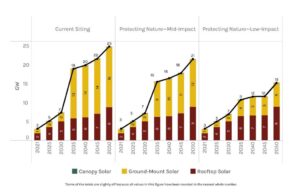
Researchers with Mass Audubon and Harvard Forest concluded that Massachusetts would only need to sacrifice a small amount of solar development to focus on balancing the clean energy with conservation efforts. Image courtesy of Mass Audubon and Harvard Forest
More than half of the land covered by parking lots in Massachusetts could host solar panel canopies, and almost four times that much rooftop space is also viable, according to a new report that urges policymakers to balance solar expansion with conservation.
Research from Mass Audubon and Harvard Forest found that construction of ground-mounted solar arrays has wiped away thousands of acres of forests in the past decade-plus, in the process reducing wildlife habitats and preventing more greenhouse gas emissions from being naturally captured and sequestered.
The groups concluded that by deploying incentives and a more deliberate focus, policymakers can protect natural and agricultural lands while still achieving most of the projected growth in solar energy.
“We can do both. We can have the solar, we can protect the nature. It is not a zero-sum equation,” said Michelle Manion, Mass Audubon’s vice president for policy and advocacy and an author of the report. “When you actually include the loss and the cost of the losses to nature into working lands, it’s not very clear that it’s cheaper to do the large ground-mount systems on those lands, so we really need to do full-cost accounting when we think about the true costs of how we build out this incredible resource.”
The report seeks to resolve a common tension of the clean energy expansion — how to balance the need for new infrastructure with the impact that it will have on communities and ecosystems — by encouraging an approach that takes both needs into account.
Since 2010, more than 5,000 acres of natural and working land have been converted into ground-mounted solar arrays, according to the report.
Authors estimated there are 119,000 acres of rooftops in Massachusetts that are viable to host solar panels. About 35,000 of the 55,000 acres covered by parking lots could host solar panel canopies above the surface, they said.
Jonathan Thompson, a senior ecologist with Harvard Forest who also led the study, said the state has 20.6 gigawatts of solar rooftop potential and a bit less than 10 gigawatts of parking lot canopy solar potential.
Parking lot canopies tend to be more expensive than other solar power options, so authors said the state will need to invest resources to incentivize that shift, such as through reducing labor and permitting costs.
Authors warned that although solar power is vital to the state’s clean energy and climate goals, clearing too much land for new installations does damage not just to wildlife but to the overarching effort itself.
Natural ecosystems and soil on farms absorb about 10 percent of the state’s greenhouse gas emissions each year, according to the report.
“Under the current siting scenarios, we would cut down 5.8 million metric tons of CO2 from forest land. That’s a hard number to absorb,” Thompson said. “It’s the equivalent to the energy use from 730,000 homes in Massachusetts. We would also lose about 21,000 acres of our high biodiversity lands, and we lose over 8,000 acres of prime farmland soil.”
By trimming that side of the net-zero ledger, authors said, the state would create even more work for itself to accomplish on the emissions-reduction front.
“If we lose those forests and we don’t have that free carbon removal, we’re going to have to make it up on the back end, somehow, in that 2030 to 2050 timeframe, probably through additional greenhouse gas emission reductions,” Manion said.
Lawmakers and the Healey administration are attempting to shift Massachusetts to clean energy sources to comply with the net-zero by 2050 state law, which also lays out interim targets along the way.
For years, officials projected that offshore wind would be a pillar of the sweeping campaign, but Massachusetts and other states have run into difficulty building momentum behind the nascent industry amid price increases.
Manion suggested the “uncertainty” in the offshore wind sector could make solar power an even more important cog in the clean energy machine.
“Solar is more competitive with what looks to be more expensive offshore wind in our near future,” she said. Manion later added, “We know we need another at least five gigawatts of solar by 2030, probably even more given the challenges for offshore wind at the moment.”






